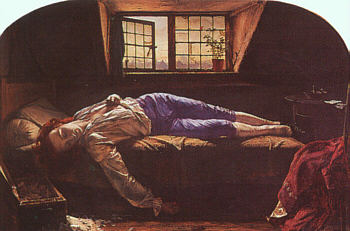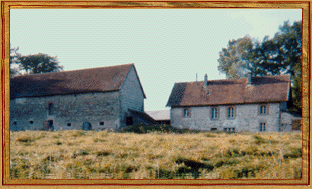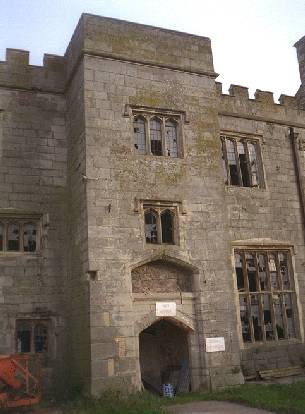Lecture IX.a--The Gothic World of the Bronte Sisters
Wuthering Heights While many people come to Wuthering Heights the book after having seen and heard about the movie, and while others have some idea of the story, we may have a slightly different set of reactions to Wuthering Heights. Because we have been looking at the evolution of women's writing, and fiction and poetry in general, through many ages, it is apparent to us that this work represents a very innovative and new use of the Romantic subject-matter. Like Jane Eyre, Emily's world of Wuthering Heights is not peopled with dukes and ladies, queens and kings. Nor is it inhabited only by upper-middle-class gentlepeople, sure to marry up (like Austen's characters). Instead, we have our first real view, in Wuthering Heights, of the kind of backwardness, brutality, and oppression, and class conflict that probably existed in many places, in those days.
First, some publishing details: Wuthering Heights was published in 1847, under the pseudonym "Ellis Bell" - the name which Emily had taken for the publication of the poems of the three sisters. The poems only sold two copies, so there was little public response except to wonder about the "he" that was the "Currer Bell" who authored Jane Eyre. It had modest success with nineteenth-century readers; many still thought it a wicked book. But in the recent century it had a wide readership: In British public libraries in 1991-2 it was the third most-borrowed book, and in 1994 it was available in some 27 editions. It has been translated into 26 languages and has generated 36 collections of illustrations, 23 stage plays, 14 musicals, 11 radio and 5 TV adaptations, 8 films, and 12 later novels based on the story. In the contemporary mind, it would seem that the lingering image of Wuthering Heights is the agony of Heathcliff over the loss of his beloved Catherine, the specter of their stormy love [think of Lawrence Olivier and Merle Oberlin in William Wyler's 1936 movie version]. But, in much the same way that we found a kind of hidden coda in the Monster of Dr. Frankenstein, so it is that we can see another set of considerations if we look at the setting, the character of Heathcliff, the nature of the conflict between Heathcliff and Linton, and the situation of Catherine Earnshaw in the story of Wuthering Heights.
THE SETTING: First, we want to look closely at the setting as it is reflected in the text. As we saw with Aphra Behn, and surely with Mary Shelley and Jane Austen, writers of novels, just like poets, are crafters of words. Emily Bronte, however, is a writer that we can trust to create several layers of ambiguity in her texts. Let us examine the text itself as a way of seeing what else, other than writing a tragic romance, she might be doing. In the opening scenes of Wuthering Heights, a Mr. Lockwood, our narrator, introduces us to his new landlord. While we may not immediately catch the implications of this first scene, they are critical to our understanding of the Heathcliff that we are to meet. First, although I have said that we tend to have "pictures" in our minds of the landscape and places that Emily is writing about, we need to notice that this house is not your typical English Country House.
We are told right away that the arms over the fireplace identify the house as having been built in the 15th Century. (I have included some 15-th Century Castles, houses, and outbuildings to give you an idea of both the solidity and the sparseness of the architecture of this period. Also, if you can imagine a place that has been in disrepair for decades, with packs of dogs living in the main hall, well.) These building were very old even in Emily's time - and we are talking, here, not about a stately manor, but about a kind of fortress-type building (we are told how thick the walls are, how deep the windows sit in the walls).
First of all, we notice that, upon entry to the "house" at Wuthering Heights, Lockwood enters into the Main Hall directly; there is no reception chamber, no anteroom, nothing, just a direct entry to the family room. And the general description is of a place barren of furniture, cold, dank, and probably, to our lights, dirty. It is, however, full of the materials of an agricultural reality: dogs, guns, oakcakes, and hams. [It will be interesting for you to note, by the way, the differences between Heathcliff's house and Thrushcross Grange, where we have many luxuries, carpets, drapes, lapdogs, etc.]
These are from an old castle in Wales that probably fits the bill for us to see what Wuthering Heights might have looked like.
From Chapter One. From Chapter One.: One stop brought us into the family sitting-room, without any introductory lobby or passage: they call it here 'the house' pre- eminently. It includes kitchen and parlour, generally; but I believe at Wuthering Heights the kitchen is forced to retreat altogether into another quarter: at least I distinguished a chatter of tongues, and a clatter of culinary utensils, deep within; and I observed no signs of roasting, boiling, or baking, about the huge fireplace; nor any glitter of copper saucepans and tin cullenders on the walls. The apartment and furniture would have been nothing extraordinary as belonging to a homely, northern farmer, with a stubborn countenance, and stalwart limbs set out to advantage in knee- breeches and gaiters. Such an individual seated in THE CHARACTER OF HEATHCLIFF: Next, we want to look at the reception that Lockwood gets--and what that says about the character of Heathcliff.. We are, today, used to much more casual manners - but in the time that Emily writes about, a "gentleman" like Heathcliff would be expected to follow a rather elaborate code of conduct, a primary feature of which would be solicitude for any legitimate guests that came to his door. THE CONFLICT BETWEEN HEATHCLIFF AND LINTON THE POSITION OF CATHERINE And why should this be so? The
ththe The novels of the Brontė sisters, which they began publishing in the late 1840's, have links to the Sensation Fiction
writers [which we will be looking at next week]. They contain extreme dramatic events, and sometimes mysterious goings on - such as the strange events in the attic in Charlotte's
Jane Eyre (1847). Emily Jane Brontė wrote only one novel that survives today, the outstanding Wuthering Heights (1847).
|
|
Literature 45 - Women in Literature : Marjorie C. Luesebrink, MFA Contents: Announcements // Discussion Page // About Your Class // Class Syllabus // Lecture Notes // Discussion Group // Reading List // Recommended Reading // Assignments // Resources and Web Sites // Grading Policies // Contact Your Instructor
|








